The Bottle Game
A common prescription for a happier life is mindfulness. Being here now. Paying attention as you carry out your daily tasks.1See the section on “Washing the dishes to wash the dishes,” Thich Nhat Hanh, The Miracle of Mindfulness. (Rider, 2015) p.3.
My partner and I keep cases of bottled mineral water in a stack in the kitchen. The particular brand we’re drinking at the moment has 15 bottles to the case, three rows of five bottles each. One day it occurred to me that I could continue to randomly grab any bottle from the box, or I could make a conscious choice of a particular bottle—based, say, on the pattern that would be left in the box.
From that moment on, I was no longer grabbing a bottle of fizzy water. I was playing the Bottle Game.
Certain rules felt intuitively obvious to me. For instance, the pattern left in the box should be symmetrical if possible. If a move resulted in an imbalance, as was inevitable, the next move had to restore symmetry. Because the box had to balance on top of other boxes, I tried to remove inner bottles before outer bottles.
I came up with names for certain patterns I encountered along the way, and got a small pang of pleasure when I achieved one of them.
Imagine you are looking down on the box and that the black circles are the metal caps of the bottles. My traditional first move was to take the center bottle, C3.
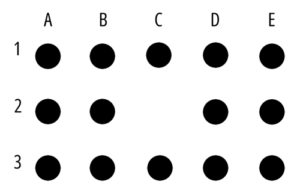
This led to the first recognizable pattern, the Square.

Next comes L7.2From the 1950s slang expression for a “square,” someone who is not hep.
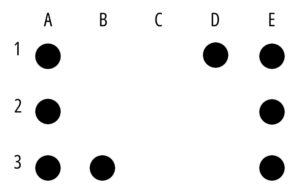
And finally the Two Arrows.
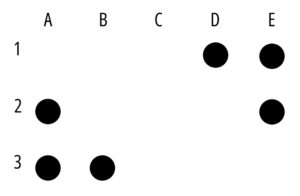
The last two bottles standing could be, for instance, A3 and E1—there’s a bit of leeway there.
Here’s the kicker, though. I’m not the only one taking bottles out of the box. My partner is equally likely to pull a bottle, but not in a conscious way. For a while I just accepted this, as acceptance is a big part of mindfulness—judging hinders observing. If she made a “wrong” move, I would either fix it with my next move (if possible), or make a correction, which of course she never noticed. Who the hell notices the pattern of soda water bottles in a case?
But I wanted more. Eventually, after she unthinkingly attained one of the patterns, I complimented her. “Nice move.”
“What?”
“See how you made a perfect square of bottles?”
By this time she was used enough to my weirdness to not panic and call the strait jacket folks. “Huh,” she said. As she walked away, I could see she was chewing over the concept that taking a water bottle out of a box could be a “move.”
I confined myself to praising various correct moves for a while, then I carefully introduced the idea of a “wrong” move. I never told her the rules, just let her figure them out. And before long she was into it, and playing the game with me. It was a game with no stakes, no losers, no importance, just a way of adding a little more presence to our days.
Then came the day when she opened a new case and left the following pattern:
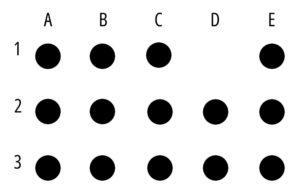
She came into the kitchen and saw me staring at the bottles. She smiled and said something like, “Why not?” After some pondering on my part, I thought, Why not indeed? There was only one fully symmetrical move at that point, so I took it.
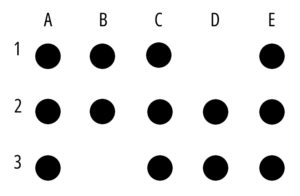
The next two moves were likewise obligatory, leaving the following configuration:
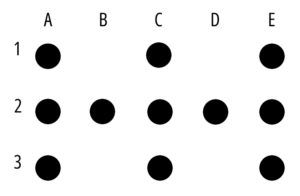
It was a new pattern, the Double H, something we had never seen before. We stood and held hands and gazed at it for a few seconds and then we went on with our lives.
You won’t find the Deluxe Home Version of the Bottle Game at Amazon.com.3You will find the bottles, but as somebody famous said—was it Wittgenstein?—“The Bottle is not the Game.” But the more you are fully present in your life, the better the chances of finding your own games.
Your move.
Notes
- 1See the section on “Washing the dishes to wash the dishes,” Thich Nhat Hanh, The Miracle of Mindfulness. (Rider, 2015) p.3.
- 2From the 1950s slang expression for a “square,” someone who is not hep.
- 3You will find the bottles, but as somebody famous said—was it Wittgenstein?—“The Bottle is not the Game.”
[created 16 Dec 2022; revised 5 Jan 2023]
